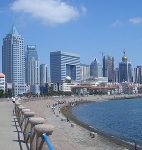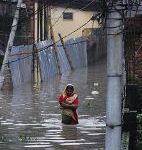Countries across the world will have to dramatically increase investment in dams, pipes and other water infrastructure to avoid widespread flooding, drought and disease even before climate change accelerates these problems, experts have warned.
Investment needs to be at least doubled from the current level of US$80 billion a year, an international congress was told in early September, and one leading authority said spending needed to rise to 1.5% of gross domestic product just “to be able to cope with the current climate” — one thousand times the current level.
The warnings follow months of dramatic events, from hurricane flooding in the Caribbean and the United States to desperate measures in drought-stricken Mediterranean countries, including importing water by ship.
Rich nations suffer huge under-investment, but the threat of poor infrastructure to populations in developing countries is even greater, said Olcay Unver, director of the United Nations’ Global Water Assessment Unit.
So serious is the problem that next year the UN’s upcoming World Water Development Report will make one of its main messages the need for investment to “accelerate substantially”, said Unver. “You can’t justify the deaths of so many children because of lack of infrastructure or lost productive time of people [who are] intellectually or physically incapacitated because of simple lack of access to safe water or sanitation,” he added.
Glen Daigger, senior vice-president of the International Water Association (IWA), said there was growing evidence that spending on clean water and sanitation was the single greatest contribution to reducing disease and death. The UN has identified dams for hydropower and irrigation as leading drivers of sustainable economic growth in developing countries. “Water and sanitation is clearly a better investment than medical intervention, but it’s not sexy,” added Daigger.
Last year the World Bank called for investment in water infrastructure to more than double from US$80 billion to US$180 billion over the next 20 to 25 years to cope with population growth and climate change. Those developments are expected to leave about four billion people living in “water stress” areas — deemed to have insufficient water to meet daily needs. Conditions would be particularly severe in Africa, the Middle East and South Asia, said the bank. Water pollution and the threat to coastal areas of erosion, sea level rise and storm surges also are growing concerns.
However, experts at the recent IWA conference of 2,700 water professionals, held in Vienna, suggested the true scale of the problem could be much higher.
Pavel Kabat, one of the lead authors of the water chapter in last year’s report by the UN’s Intergovernmental Panel on Climate Change (IPCC), said investment needed to rise to 1.5% of gross domestic product (GDP) for 20 years just to cope with existing population demand and climate variability. Africa, the region with the greatest lack of infrastructure, would have to spend its entire forecast GDP growth for more than half a century even to reach relatively modest levels of water storage and supply; and even Europe would have to triple spending.
Failure to invest would mean “we’d have more recurrent floods and droughts because our systems are not able to take the magnitude and frequency of water we’re witnessing,” he said. It would also undermine other development spending in poorer nations, said Kabat, citing the example of Kenya, where, he said, two extreme years of wet and dry in the 1990s destroyed 40% of the country’s wealth. “If these things are not in place, we can keep on building schools but we’re not doing the right thing,” he added.
Among the proposals to reduce costs, water users would have to accept different grades of water, including a lower grade in gardens and toilets, said Alexander Zehnder, of the Alberta Water Research Institute in Canada. “Why are we spending a lot of money to clean the water and then we piss in it?”
Earlier this year, the American Society of Civil Engineers (ASCE) said the United States needed to spend $1.6 trillion over five years to repair its entire crumbling infrastructure, and gave the worst assessment of all to the water sector. Federal funds for drinking water were less than 10% of what was needed.
In the United Kingdom, the Institution of Civil Engineers (ICE) said that, despite significant investment since water privatisation in 1989, many mains pipes were extremely old and in poor condition, and under-investment in new reservoirs had led to “insufficient winter reserve storage to sustain supplies in extreme conditions”.
Last year’s UK floods exposed fears about the safety of a reservoir dam in Yorkshire, leading to 100 homes being evacuated. More recently, on September 10, the Chartered Institution of Water and Environmental Management (CIWEM) warned that floods were having “devastating” health, social and economic consequences.
“Impacts can range from immediate death, injury and harm from contaminated water, through to lasting psychological consequences caused by damaged homes, loss of personal possessions and financial worries,” said the London-based institution.
—
A word on water stress
Water stress is defined as having less than 1,000 cubic metres of water a year per person. By this definition up to 2.1 million people already have too little, and population growth and more variable rainfall threaten to make this much worse.
The problems are acute in south-east Asia and Africa, but Africa is least able to cope. Average US storage capability is 6,000 cubic metres; in China, it is less than half of that and in many countries in Africa it is minuscule. To bring the region up to South Africa’s level of nearly 750 cubic metres would need all the estimated 5% to 7% rise in national income every year for up to 80 years.
Copyright Guardian News and Media Ltd. 2008
Homepage photo by The Humanitariancoliation.ca


